Nearly 9,000 union members, close to one-third of the membership, responded to the PSC’s first-ever electronic survey. It was available to members in the latter half of May. One poll administrator who conducts union surveys noted that such a turnout was “as good a response rate [as] you can hope for.”
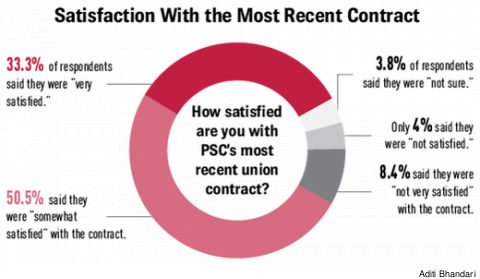 |
Members answered survey questions at a critical time for the union. Last year, the PSC settled a long overdue contract, and later this fall the union will begin a new round of contract negotiations. (The current PSC-CUNY contract expires on November 30, 2017.
ISSUES AHEAD
“The survey results will be important in helping the union to shape priorities,” wrote PSC President Barbara Bowen in an email to members in May. “The results will also enable us to organize with you on campus to change the conditions that need to be changed.”
Besides negotiating a new contract, the PSC, along with other public-sector unions, is likely to face a US Supreme Court decision from a conservative-majority court that will attack the union’s ability to maintain its financial and political strength.
“Knowing what matters to you is even more urgent as the Trump administration attempts to deliver a deathblow to unions’ power,” stressed Bowen in her email to members.
BIG RESPONSE
The detailed survey asked a range of questions: concerning the importance of past contract wins, the level of satisfaction with the recently settled union contract and identify the relative importance of future contract priorities and of paying union dues. The high response rate provides a strong cross-section of members’ views, but the survey was not conducted as a random sample and may not be fully representative of the bargaining unit as a whole.
With nearly a third of PSC members responding, the survey results reflect the views of those who responded, and they’re not necessarily representative of the bargaining unit as a whole. Response rates also varied by job title, from a high of 49 percent for full-time CLTs to a low of 13 percent for Continuing Education Teachers. (See June/July Clarion for a list of response rates by title series.)
The graphs below show the responses on issues facing the union now – and in the future. Complete survey results will be published later this fall.
PSC MEMBER PRIORITIES
 |
The results for this graph show where more than 30 percent of respondents identified an issue as one of their top three contract priorities for the new contract. The high prioritization that respondents in part-time titles gave to “increasing per-course pay for adjuncts to $7,000” pushed the issue up among all members’ priorities. Increased salary was clearly a top issue (72.8 percent); timely contract settlement (39.5 percent) and job security (38.1 percent) were other issues identified among the top three concerns for many members.
FACULTY AND STAFF IDENTIFY THEIR PRIORITIES
Separated by members’ title series, these graphs show the five issues that were most often included in respondents’ top three priorities.
- In all branches, over 60 percent of respondents included increased salaries among their top three priorities.
- Over half of HEO and CLT respondents included timely contract settlement among their top three priorities.
- Two potentially competing high-priority demands are $7,000 per course for adjuncts and timely contract settlement.
- Nearly half of adjunct faculty and HEO respondents included job security in their top three priorities.
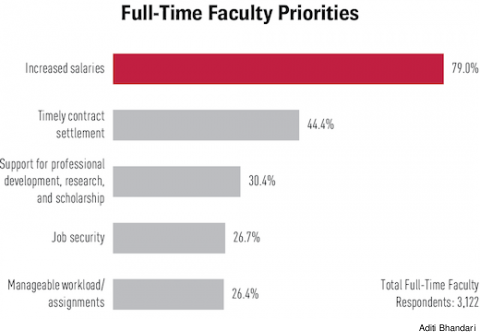
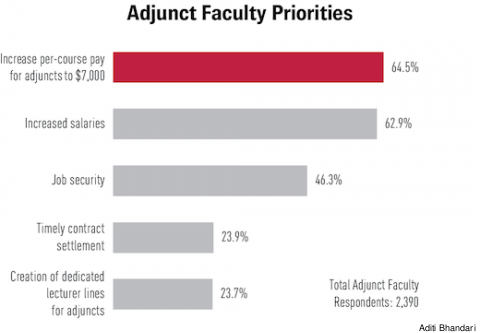
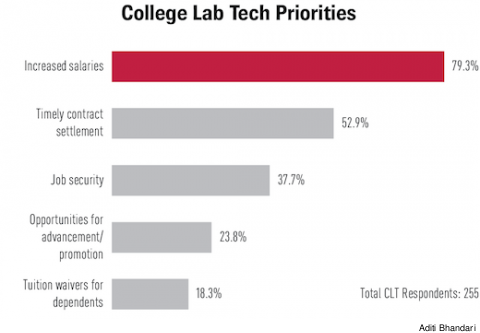
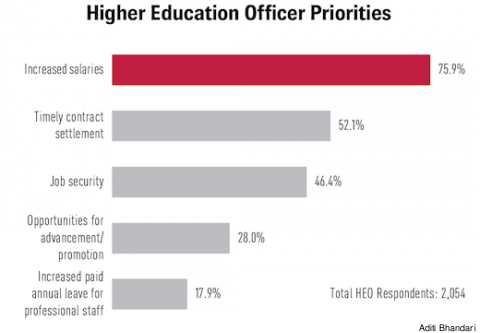
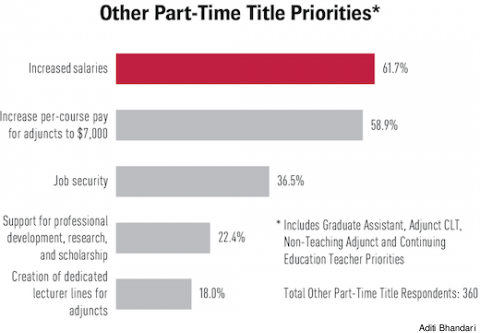
THE IMPORTANCE OF PAYING UNION DUES
If the Supreme Court limits public sector unions’ ability to collect dues or agency fees, an overwhelming majority of survey respondents (78 percent) said that it is “very important” for everyone to continue to pay their fair share; 14 percent said it was “somewhat important.”
 |
FACULTY TEACHING ONLINE COURSES
With 28 percent of full-time faculty respondents and 16.7 percent of adjunct faculty respondents reporting that they have taught or developed an online course at CUNY, protecting the rights of faculty who teach online courses is becoming a more pressing concern.
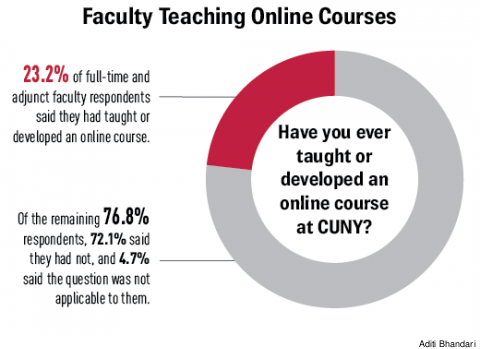
Graphs were designed by Aditi Bhandari. For a pdf of the center spread as it appears in the print Clarion, click here.

